Uninstall Vfgj file virus (Free Removal Guide) - Quick Decryption Solution
Vfgj file virus Removal Guide
Description of Vfgj file virus
Vfgj file virus is the threat marking encoded files using .vfgj marker

Vfgj ransomware is a malicious program blocking access on the machine by locking commonly used files and demanding money. The encryption process starts behind users' backs, but the behaviour of the machine indicates issues with the security later on.
Victims get encouraged to pay the ransom amount and receive the decryption tool in return. These instructions get delivered via the _readme.txt file that gets dropped on the machine in folders and the desktop where the Vfgj virus leaves encoded data. These messages, however, should be ignored since trusting these criminals cannot help recover files or remove the threat.
You as a possible victim of the dangerous threat can remove the infection yourself, but it is rarely possible to recover files encrypted by the threat without the proper tools. Official decryption tools are not available, so the Vfgj ransomware virus removal is the first and the most important step here.
| Name | Vfgj ransomware |
|---|---|
| Type | File-locking virus |
| Virus family | Djvu ransomware |
| File marker | .vfgj |
| Ransom amount | $980 in Bitcoin |
| Ransom note | _readme.txt |
| Distribution | Spam email campaigns, file attachments, pirating platforms |
| File recovery | Is not easily possible, official decryption tools are needed. Alternate options are listed below |
| Removal | Anti-malware tools are needed here because ransomware can be persistent |
| Repair | Run FortectIntego and repair virus damage, restore any damaged files |
Vfgj file virus is delivering the text file with instructions to scare people into paying the demanded sum. Bitcoin is the preferred currency of these creators. The threat is coming from the known family that is known since 2019. Particular features of the threat have not been changed for all these years.
The ransom note file and the content of the text file have been the same for these years. The contact email information get changed pretty rarely, so those are often the same for many versions. The main thing that changes is the file marker that is unique for each variant.
Vfgj virus is not decryptable and it is because of the unique encryption keys that get used during the locking process. Online ids are unique for each of the devices even when the same threat version is affecting the system. However, that means that decryption requires a particular key for the file repair.
The offline ids get used when the C&C server cannot connect to the infection, and these keys are unique for the version only. This way Vfgj ransomware has one key that can be used for the decryption of all versions. This is rare, and the tool might not work with these more recent versions like Reqg or Piiq.
When these files get marked using the .vfgj extension the original code of these files, and makes data useless, locked for possibly forever. It is not easy to recover these files yourself without any tools particularly developed for this. However, not removing the threat is important, and it is not the same as data recovery.
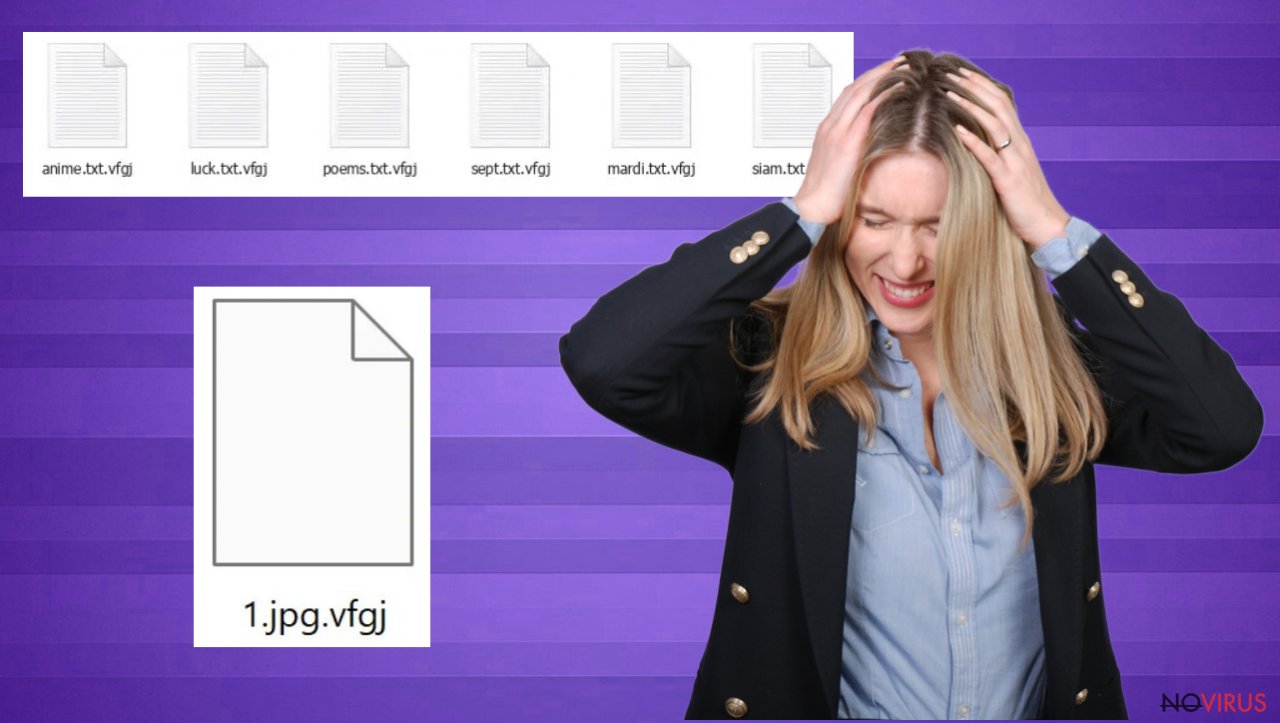
Step 1. Remove the infection
Vfgj ransomware virus can be eliminated with anti-malware tools and security applications. Antivirus applications can detect the files related to ransomware and additional threats like malware, trojans, worms. These full system scans with SpyHunter 5Combo Cleaner or Malwarebytes can reveal all potential infections.
Then you properly remove all infections and files from the machine, so the Vfgj file virus gets terminated and stopped. This is crucial because any threats left behind can affect the machine further and even trigger another round of file encryption. This is how people can possibly lose their data permanently. If you decide to pay the ransom it can be crucial for the financial losses too. This is why we never recommend paying criminals.
As for the damage, you might also experience system damage due to the infections like this. Once a computer is infected with Vfgj ransomware, its system is changed to operate differently. For example, an infection can alter the Windows registry database, damage vital bootup, and other sections, delete or corrupt DLL files, etc. If the system file is damaged by malware, antivirus software is not capable of doing anything about it, leaving it just the way it is.
Therefore, we highly recommend using a one-of-a-kind, patented technology of FortectIntego repair. Not only can it fix virus damage after the infection, but it is also capable of removing malware that has already broken into the system thanks to several engines used by the program. Besides, the application is also capable of fixing various Windows-related issues that are not caused by malware infections, for example, Blue Screen errors, freezes, registry errors, damaged DLLs, etc.
- Download the application by clicking on the link above
- Click on the ReimageRepair.exe
- If User Account Control (UAC) shows up, select Yes
- Press Install and wait till the program finishes the installation process
- The analysis of your machine will begin immediately
- Once complete, check the results – they will be listed in the Summary
- You can now click on each of the issues and fix them manually
- If you see many problems that you find difficult to fix, we recommend you purchase the license and fix them automatically.
Step 2. Check file repair options
Vfgj virus is coming after more than 300 of other variants, so this is not the decryptable version. However, sometimes it is possible to restore data using other methods. Of course, the best option would be the official decryption tool, but those take a long time to develop. You can store some of the files on an external device and wait for the development of such a tool.
Speaking on external devices and storing files. Data backups that is kept in external devices, cloud databases, platforms can be used as the replacement for the affected files. The encryption changes the original code of files, so without those copies, the encrypted file recovery is not very successful. You cannot unlock the file once Vfgj ransomware damages the piece.
Other possibilities include third-party applications designed for file repair and built-in features of the machine. Shadow volume copies often get deleted, so the machine is not capable of running the ShadowExplorer tool that can help with locked data. The worst thing about the infection is this data encryption and persistence insurance.
You can remove the threat, make sure to double-check before any other steps though, so the threat is properly removed and you can repair performance, damaged system files, disabled programs. Then the options for file recovery can be tried out. Vfgj ransomware virus is a serious threat, and you need to take it seriously. Once the machine is clean try the alternates below.
Getting rid of Vfgj file virus. Follow these steps
Solutions before the Vfgj file removal procedure
Ransomware is a threat that relies on file encryption, but this process is a separate issue from the infection. It is crucial to understand what the malicious infection does on the machine. A virus can change various parts of the Windows operating system and control how the device performs.
NOTE when you do not have backups! →
Using security programs or recovery options right away might corrupt your files permanently. This can affect the process of data decryption even when the official tool is used.
To save those encoded files, you should store them on a separate device before you go for malware removal. You can use a USB or SSD drive for this and disconnect them after transferring. Encoded files have nothing malicious in them, so it is safe. However, you need to eject the drive before removing the virus, so data damage is avoided.
If you follow the steps in the elimination guide one by one closely, it shouldn't be difficult to terminate the threat and understand how to achieve the best results. These instructions are free and should help you to remove malware and repair any files that have been affected by the infection.
If any additional questions come up, or you have a difficult time following the guide, contact us via the Ask us form.
IMPORTANT! →
You need to make sure that the threat is fully removed from the machine before you even start to recover your files. Ransomware can easily encrypt those pieces again once you recover data using the separate backups before the elimination.
Software for file restoring
Data backups are important, but users tend to skip such an important step. Also, ransomware comes without notice, so many files affected by the threat can be the ones that haven't been backed up yet. paying the demanded ransom is not the solution, so trusting criminals is not the option for file recovery.
File recovery is a difficult thing, but it is possible to retrieve those files that get affected or encrypted, in some cases. It is highly related to the fact that there are many methods to lock files. The encryption algorithm used can determine if decryption is possible. Since there are thousands of ransomware strains, it is impossible to tell if any software will work for you.
We suggest trying the program regardless of which ransomware attacked your computer. Make sure to pay attention to some details before you begin:
- Note that encrypted data on your computer might get permanently damaged by security or data recovery software, you should first make backups of it to save crucial data.
- Make sure to recover your files using this method after you perform a thorough system scan with anti-malware software.
Install file recovery software
- Download Data Recovery Pro.
- Double-click the file to launch it.

- Follow instructions to install the software.
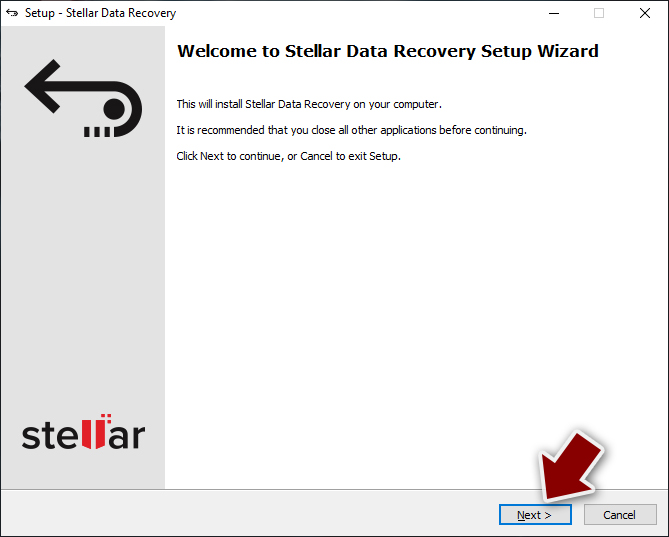
- Press Finish and use the app.
- Select Everything or pick individual folders where you want the files to be recovered from.
- Press Next.
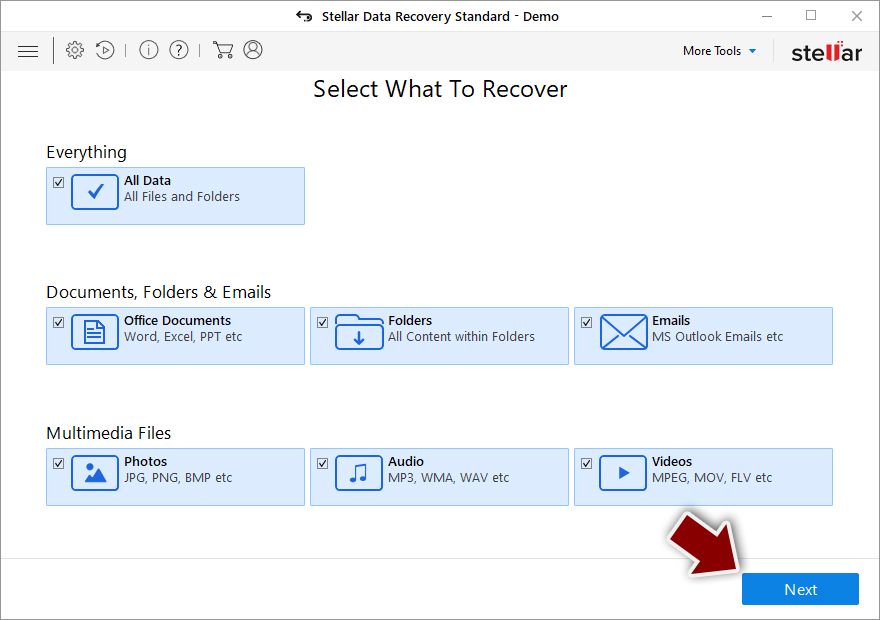
- Enable Deep scan and pick which Disks you want to be scanned.
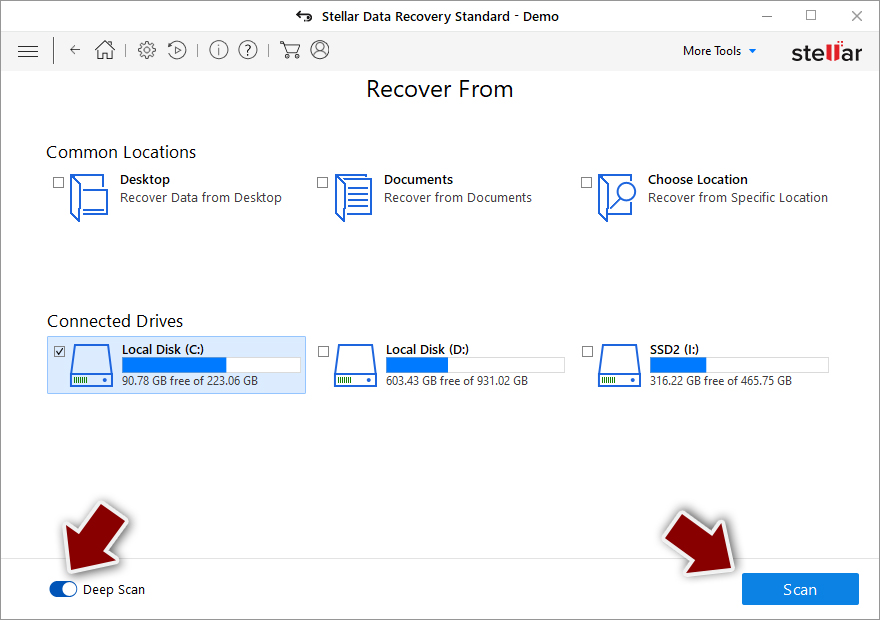
- Press Scan and wait till it is complete.
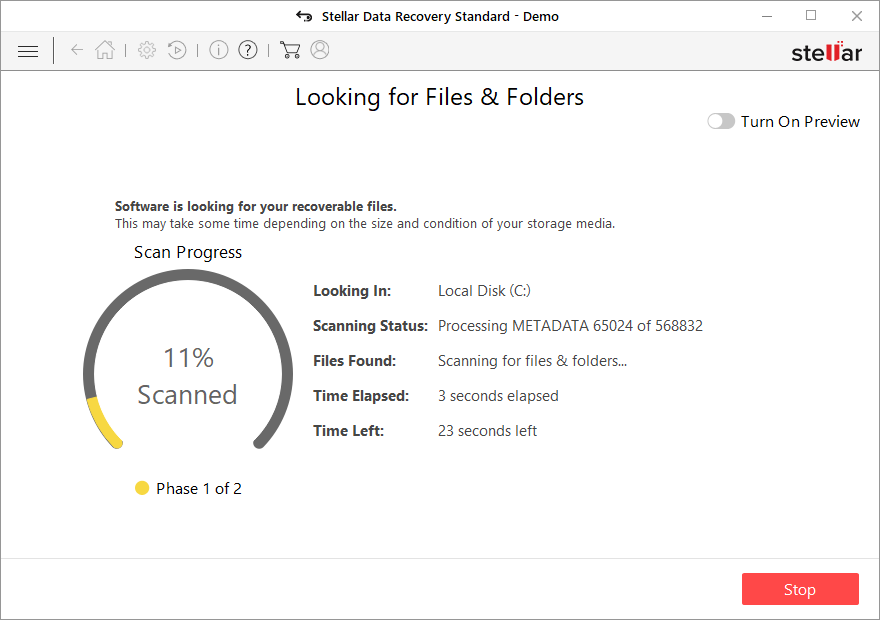
- You can choose folders/files to recover – don't forget you also have the option to search by the file name!
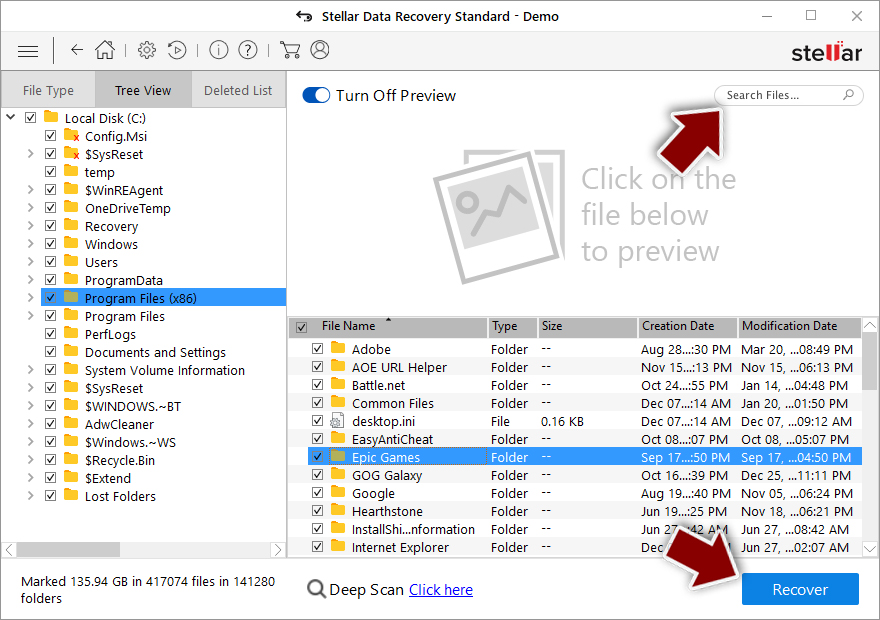
- Press Recover to retrieve your files.
In-depth guide for the Vfgj file elimination
Important! →
The elimination guide can appear too difficult if you are not tech-savvy. It requires some knowledge of computer processes since it includes system changes that need to be performed correctly. You need to take steps carefully and follow the guide avoiding any issues created due to improper setting changes. Automatic methods might suit you better if you find the guide too difficult.
Step 1. Launch Safe Mode with Networking
Safe Mode environment offers better results of manual virus removal
Windows 7 / Vista / XP
- Go to Start.
- Choose Shutdown, then Restart, and OK.
- When your computer boots, start pressing the F8 button (if that does not work, try F2, F12, Del, etc. – it all depends on your motherboard model) a few times until you see the Advanced Boot Options window.
- Select Safe Mode with Networking from the list.

Windows 10 / Windows 8
- Right-click the Start button and choose Settings.

- Scroll down to find Update & Security.

- On the left, pick Recovery.
- Scroll to find Advanced Startup section.
- Click Restart now.

- Choose Troubleshoot.

- Go to Advanced options.

- Select Startup Settings.

- Press Restart.

- Choose 5) Enable Safe Mode with Networking.
Step 2. End questionable processes
You can rely on Windows Task Manager that finds all the random processes in the background. When the intruder is triggering any processes, you can shut them down:
- Press Ctrl + Shift + Esc keys to open Windows Task Manager.
- Click on More details.

- Scroll down to Background processes.
- Look for anything suspicious.
- Right-click and select Open file location.

- Go back to the Process tab, right-click and pick End Task.
- Delete the contents of the malicious folder.
Step 3. Check the program in Startup
- Press Ctrl + Shift + Esc on your keyboard again.
- Go to the Startup tab.
- Right-click on the suspicious app and pick Disable.

Step 4. Find and eliminate virus files
Data related to the infection can be hidden in various places. Follow the steps and you can find them:
- Type in Disk Cleanup in Windows search and press Enter.

- Select the drive (C: is your main drive by default and is likely to be the one that has malicious files in) you want to clean.
- Scroll through the Files to delete and select the following:
Temporary Internet Files
Downloads
Recycle Bin
Temporary files - Pick Clean up system files.

- You can also look for other malicious files hidden in the following folders (type these entries in Windows Search and press Enter):
%AppData%
%LocalAppData%
%ProgramData%
%WinDir%
After you are finished, reboot the PC in normal mode.
It is strongly recommended to take precautions and secure your computer from malware attacks. To protect your PC from Vfgj file and other dangerous viruses, you should install and keep a powerful malware removal tool, for instance, FortectIntego, SpyHunter 5Combo Cleaner or Malwarebytes.
How to prevent from getting ransomware
Securely connect to your website wherever you are
Sometimes you may need to log in to a content management system or server more often, especially if you are actively working on a blog, website, or different project that needs constant maintenance or that requires frequent content updates or other changes. Avoiding this problem can be easy if you choose a dedicated/fixed IP address. It's a static IP address that only belongs to a specific device and does not change when you are in different locations.
VPN service providers such as Private Internet Access can help you with these settings. This tool can help you control your online reputation and successfully manage your projects wherever you are. It is important to prevent different IP addresses from connecting to your website. With a dedicated/fixed IP address, VPN service, and secure access to a content management system, your project will remain secure.
Recover files damaged by a dangerous malware attack
Despite the fact that there are various circumstances that can cause data to be lost on a system, including accidental deletion, the most common reason people lose photos, documents, videos, and other important data is the infection of malware.
Some malicious programs can delete files and prevent the software from running smoothly. However, there is a greater threat from the dangerous viruses that can encrypt documents, system files, and images. Ransomware-type viruses focus on encrypting data and restricting users’ access to files, so you can permanently lose personal data when you download such a virus to your computer.
The ability to unlock encrypted files is very limited, but some programs have a data recovery feature. In some cases, the Data Recovery Pro program can help recover at least some of the data that has been locked by a virus or other cyber infection.
